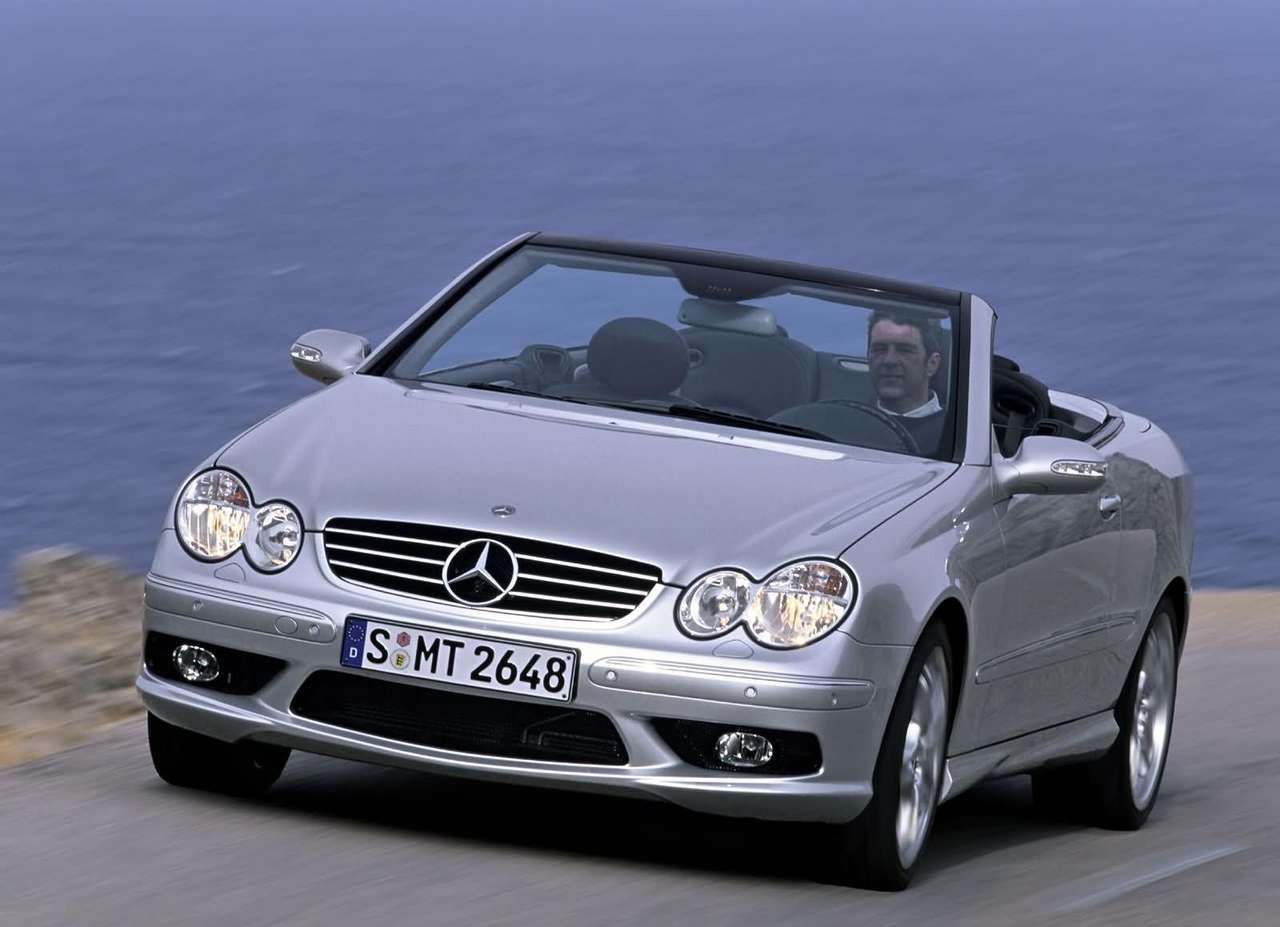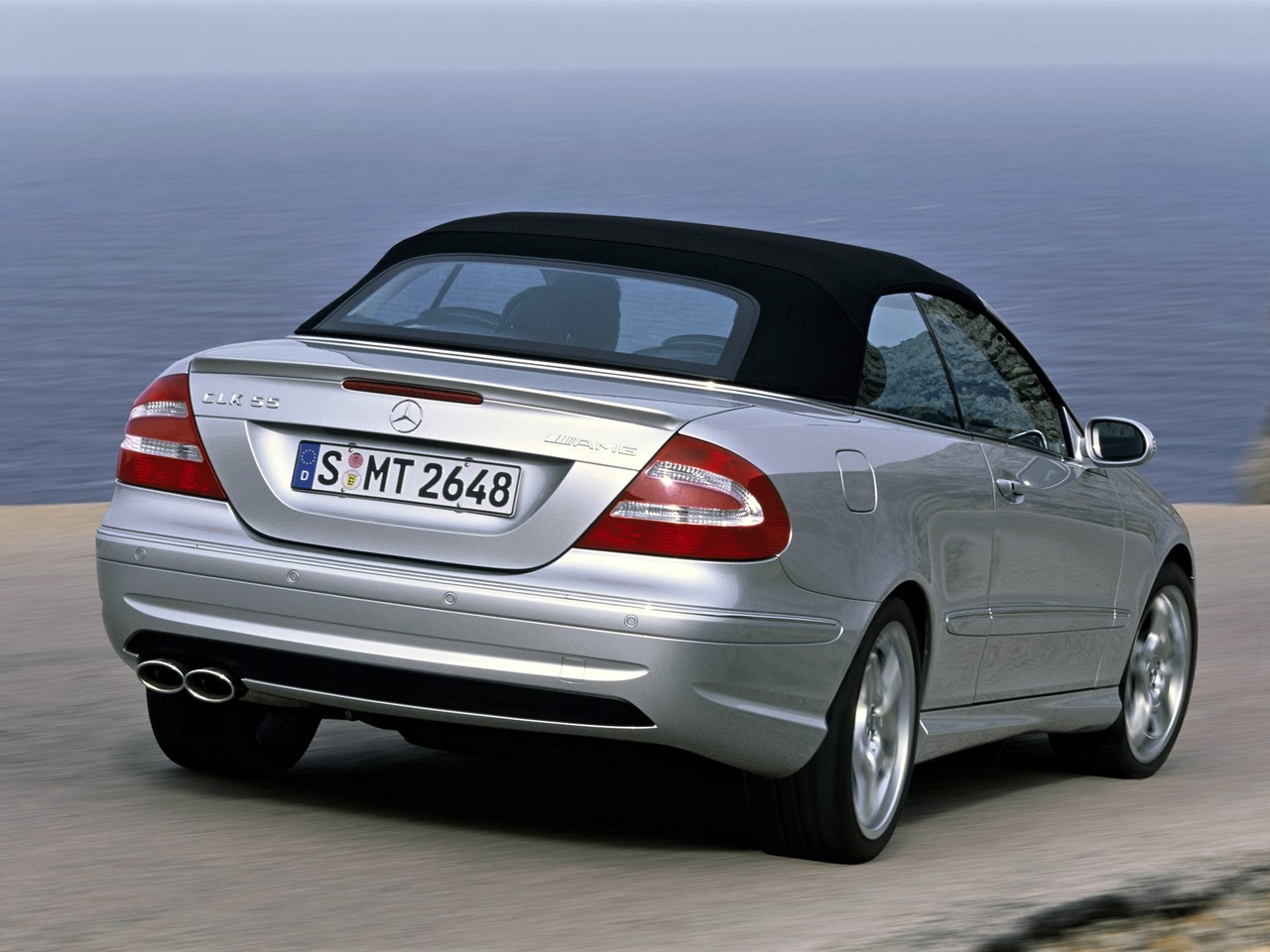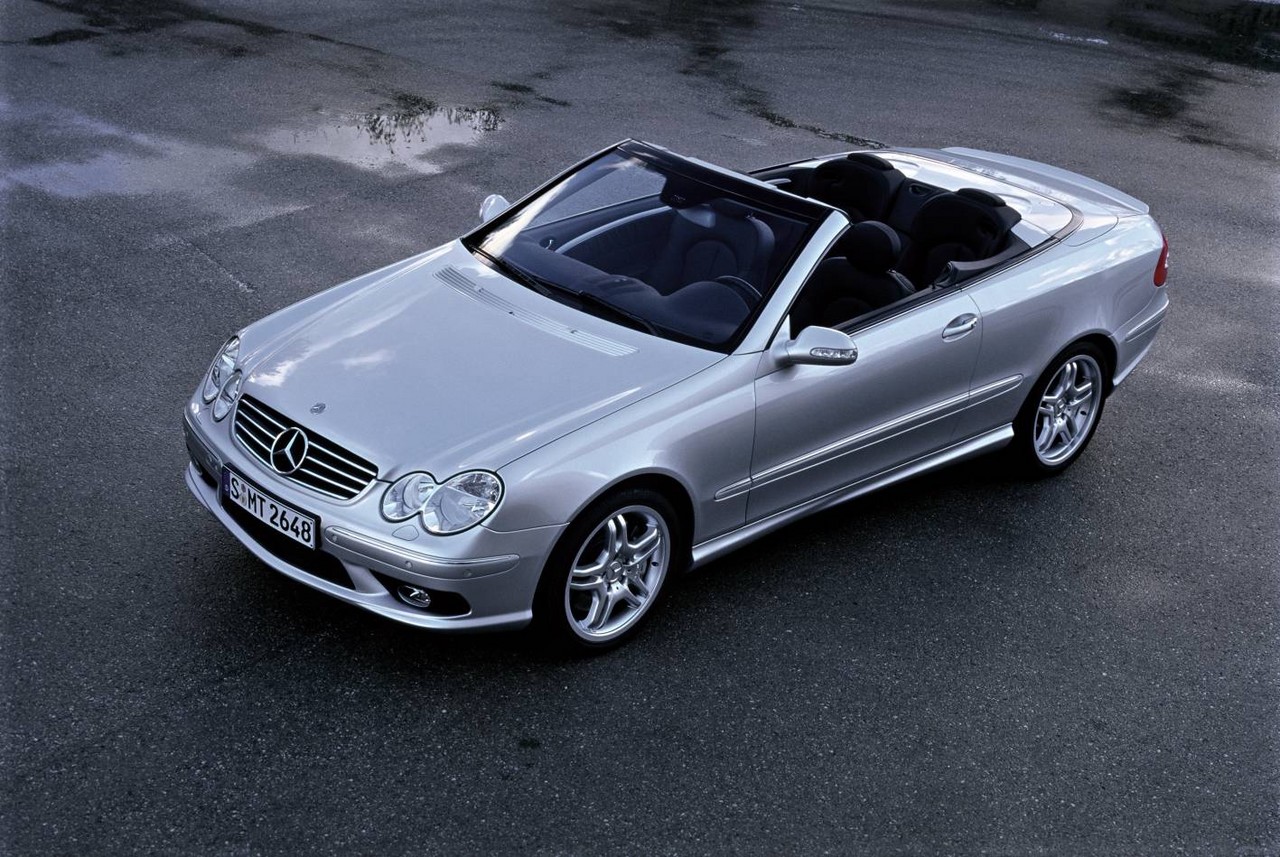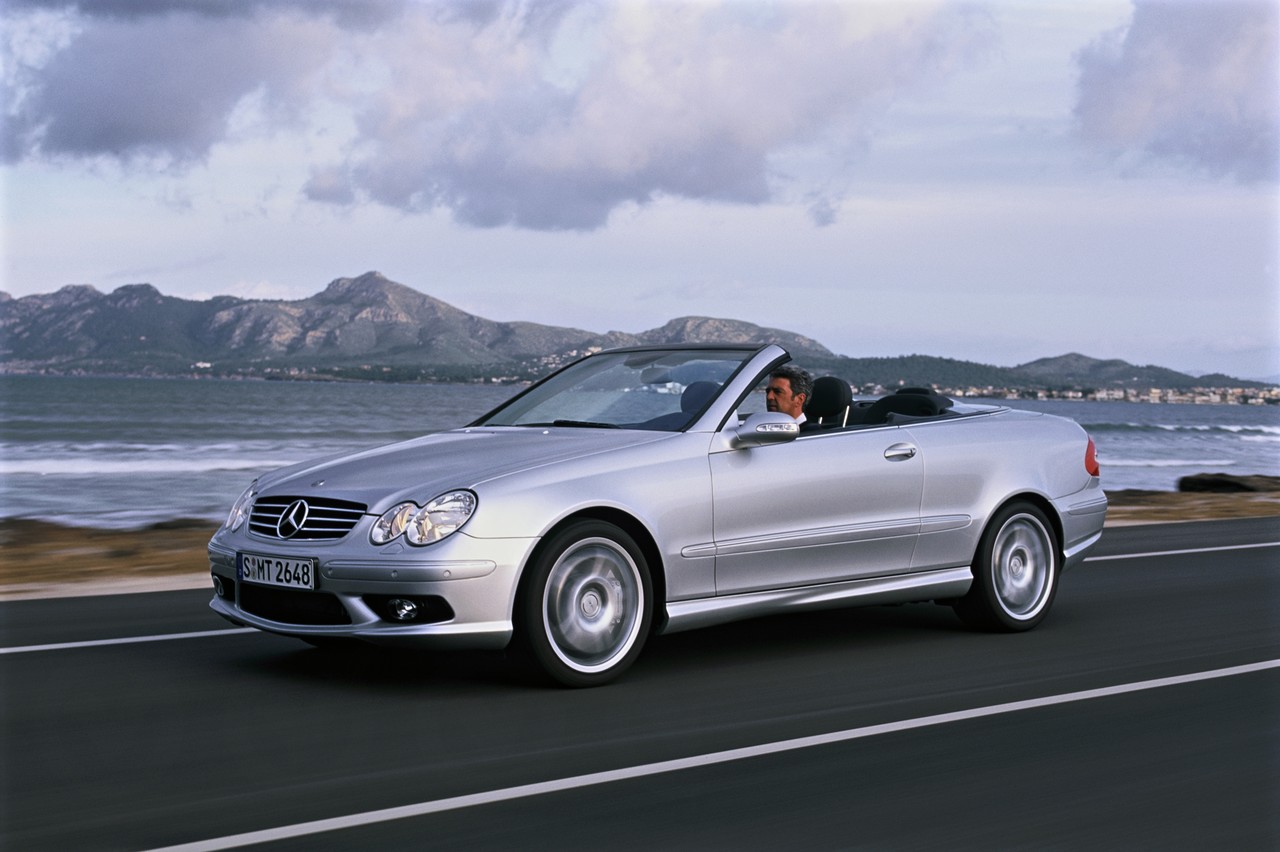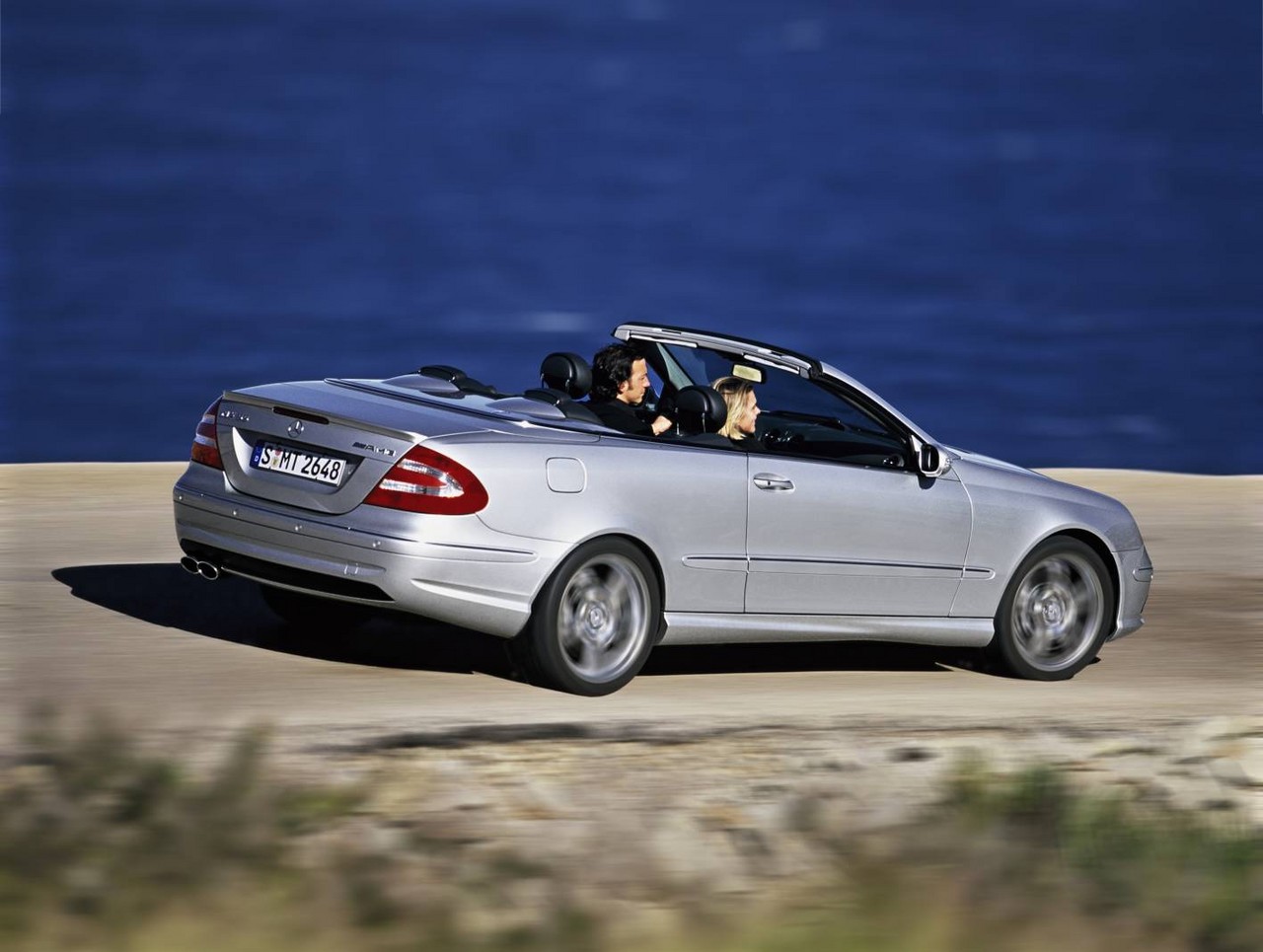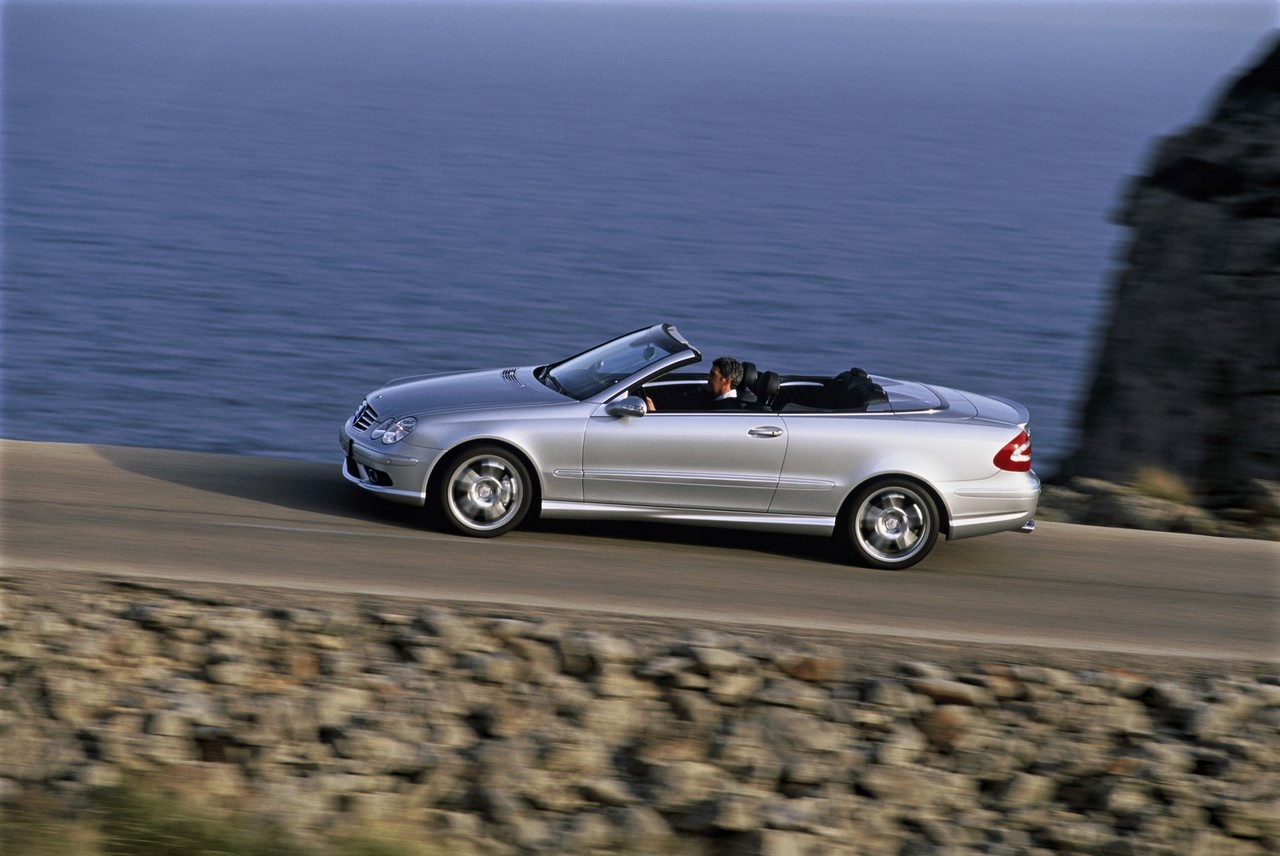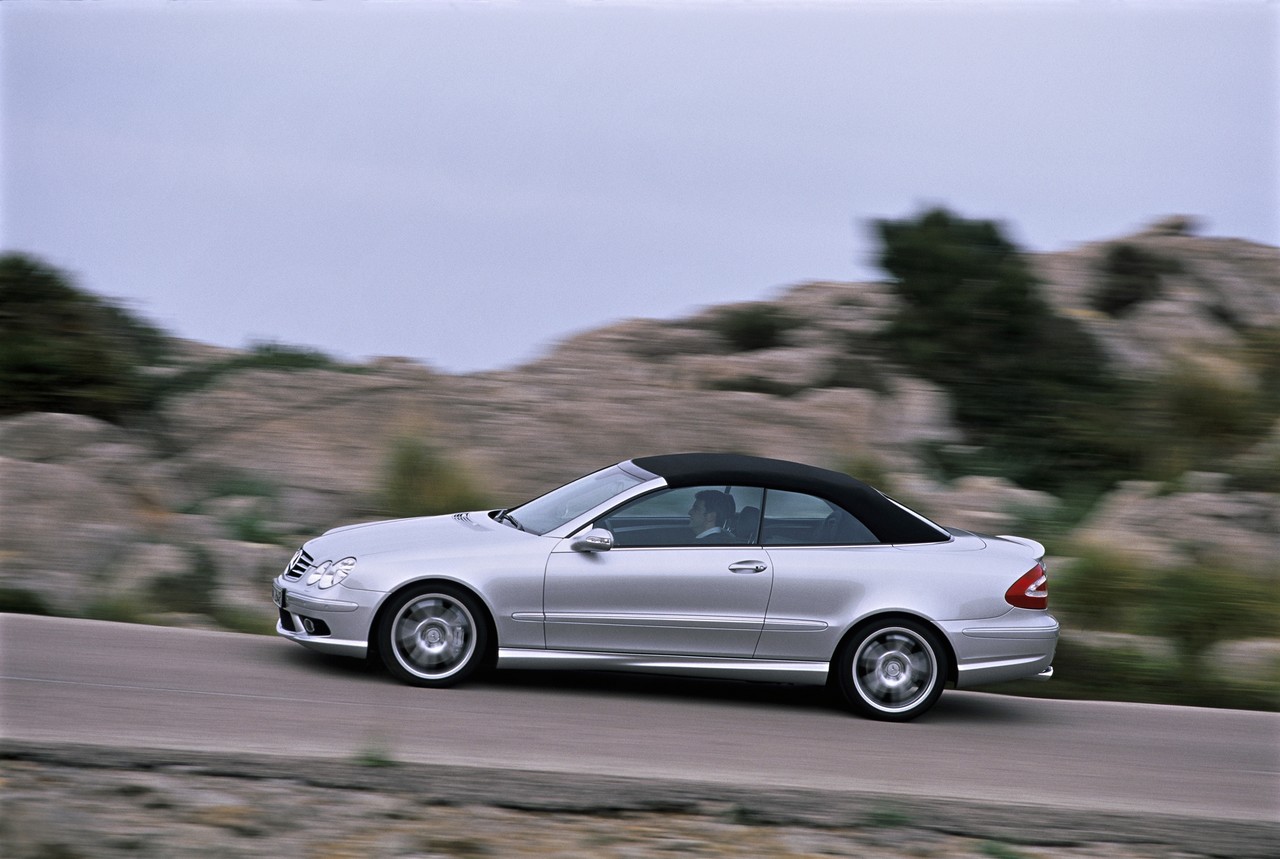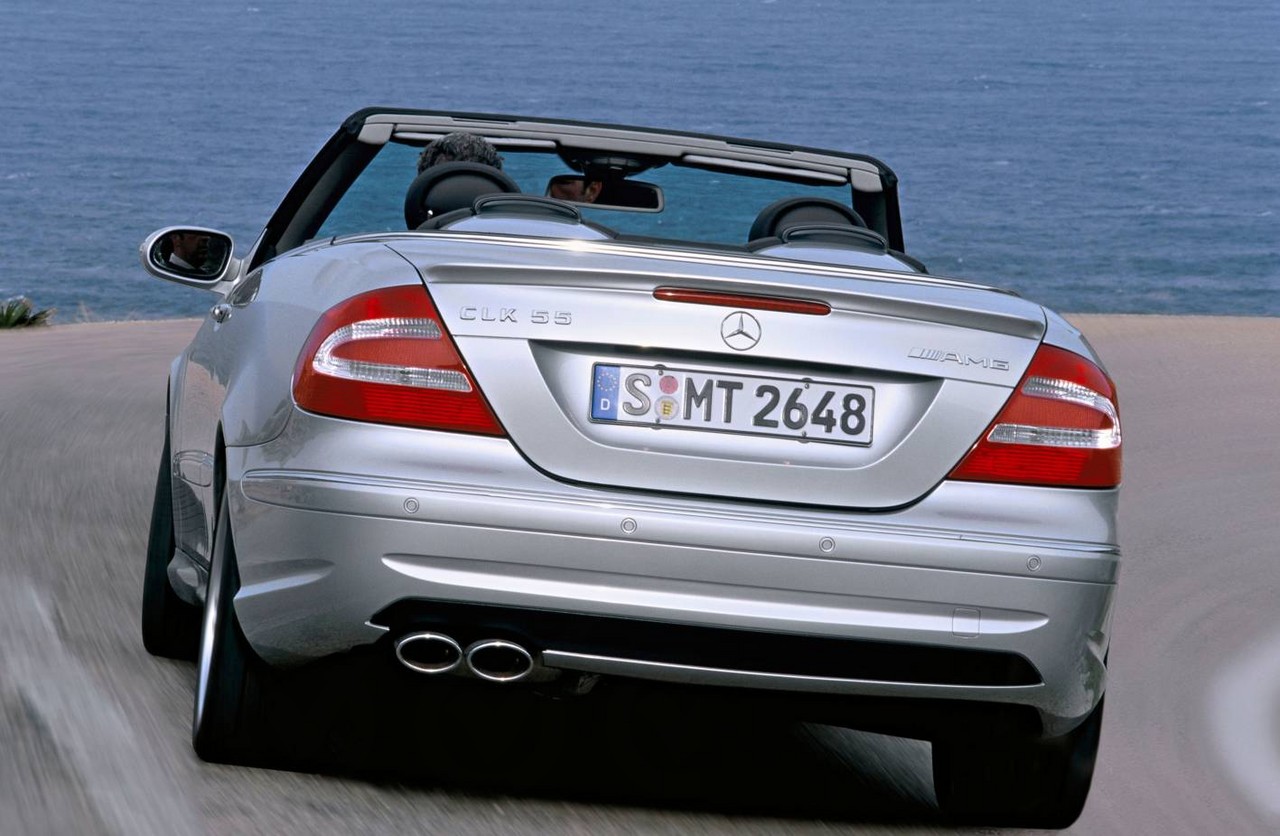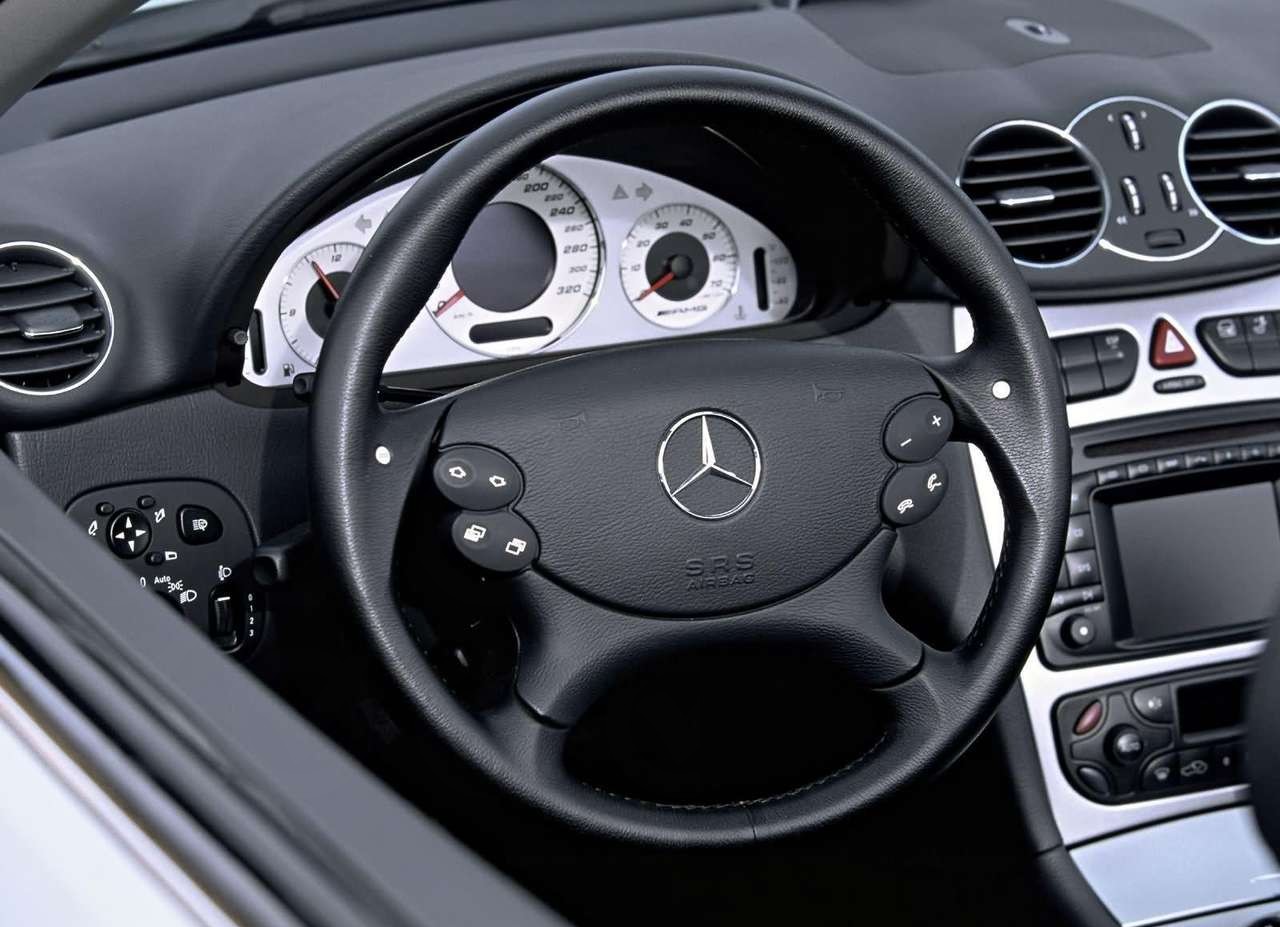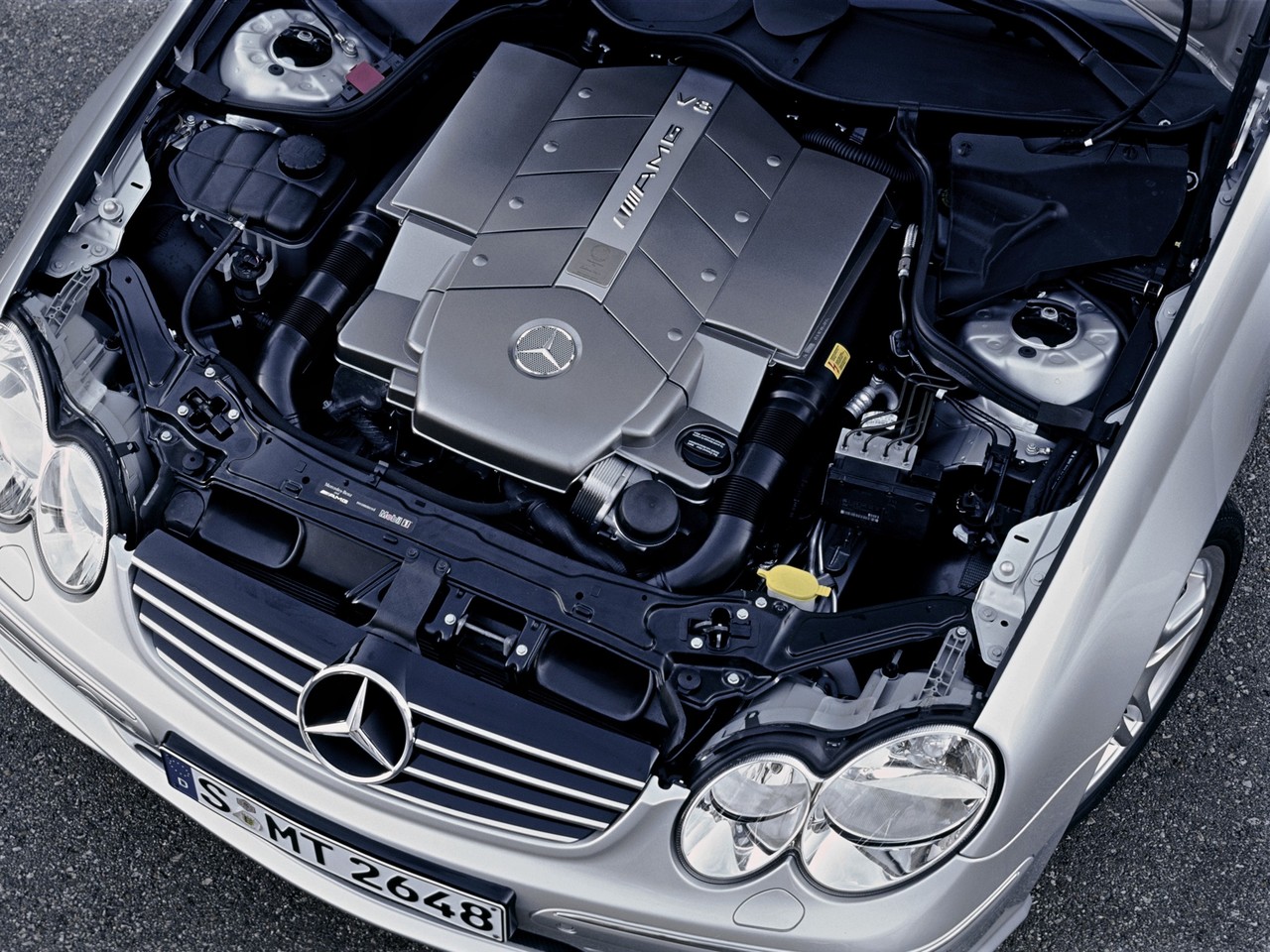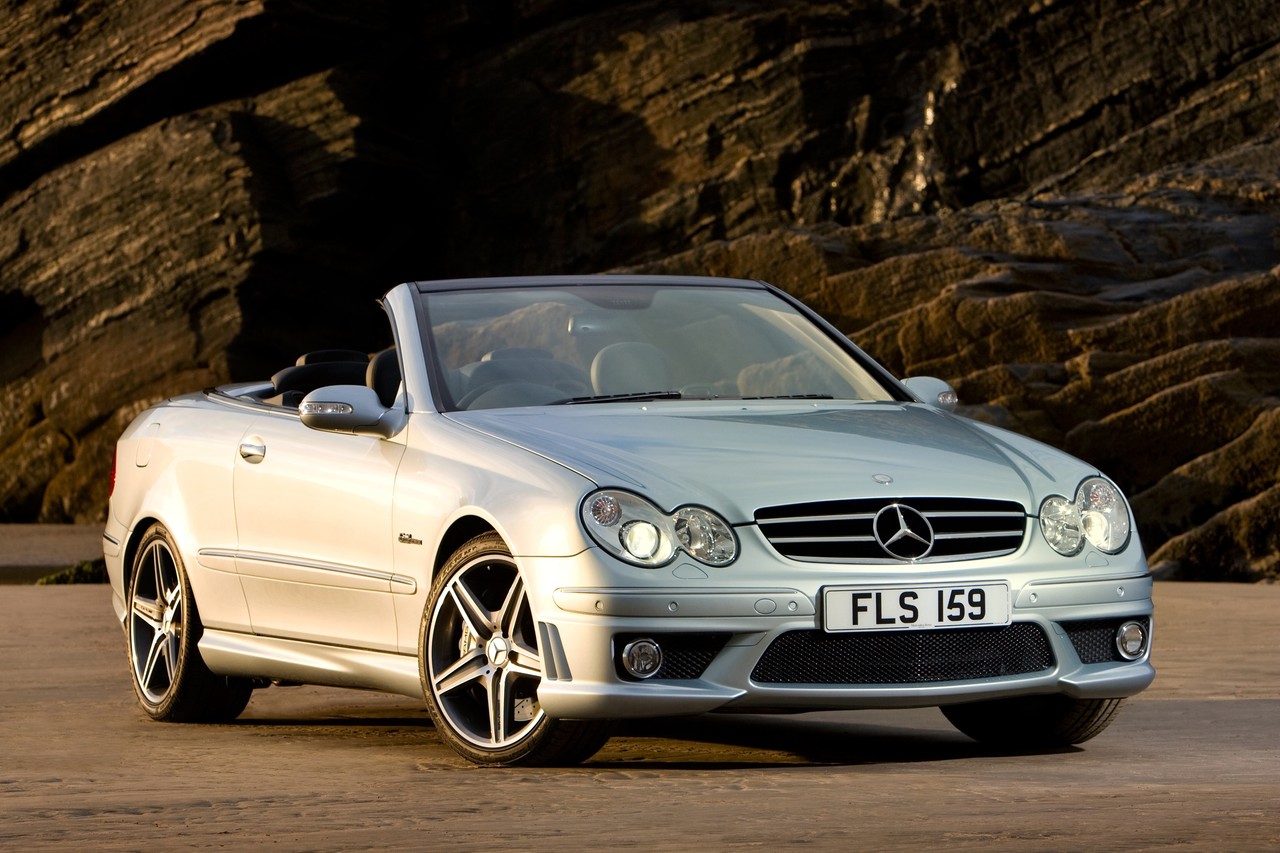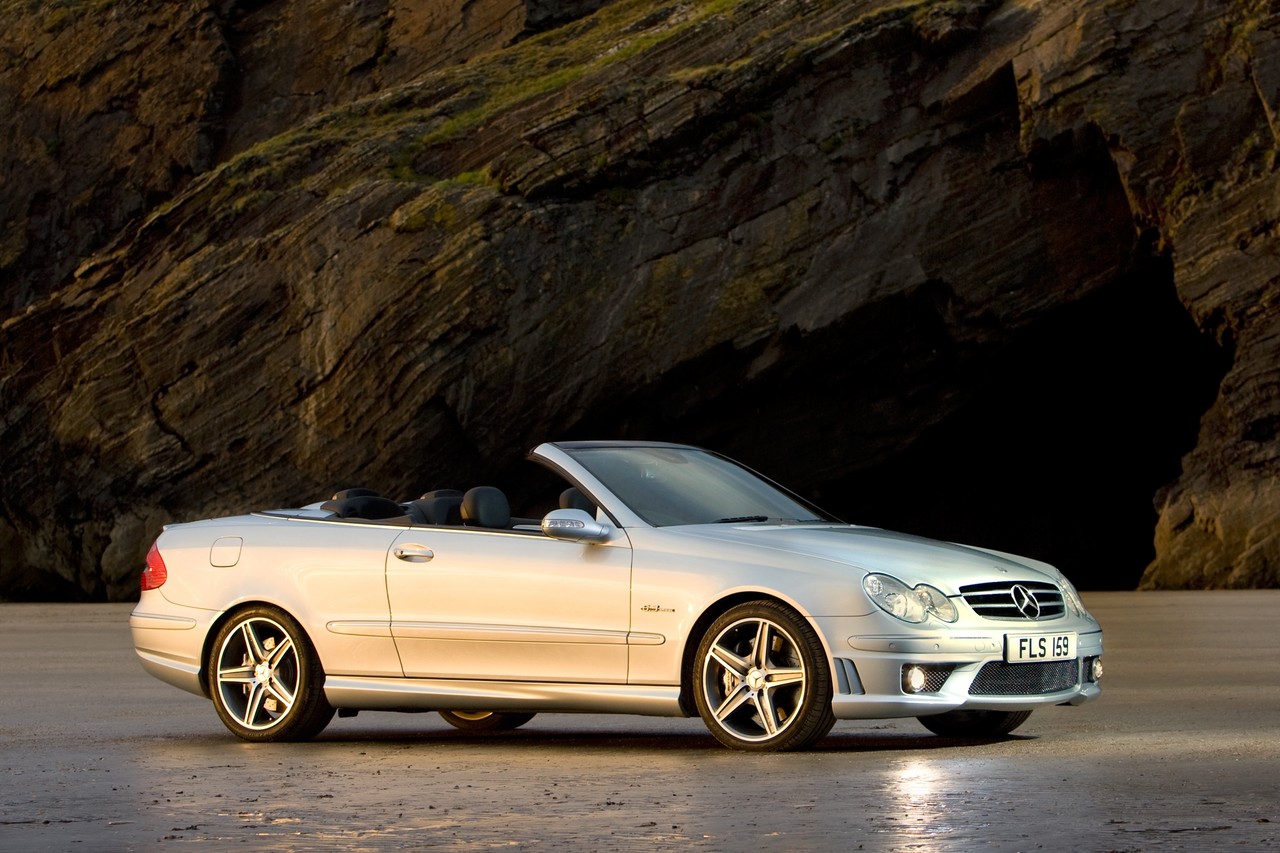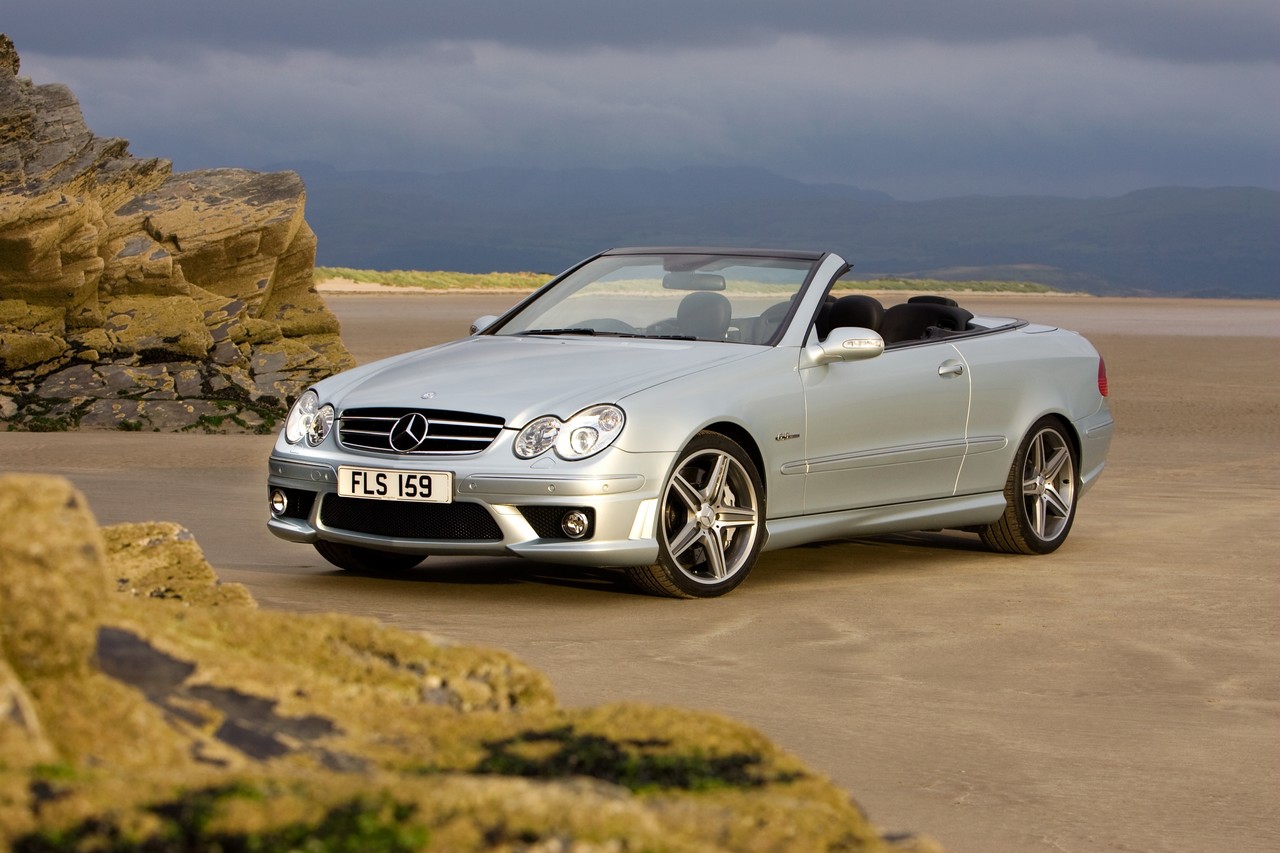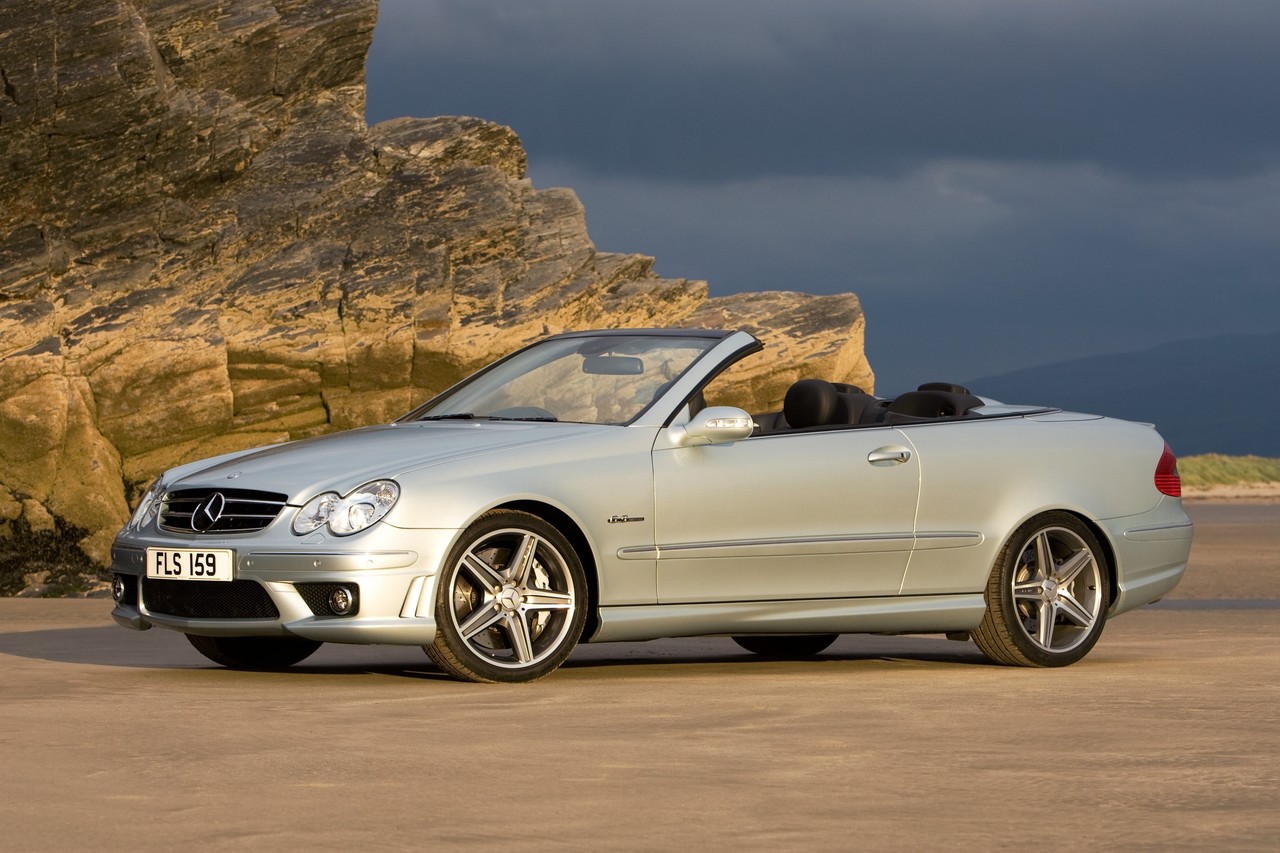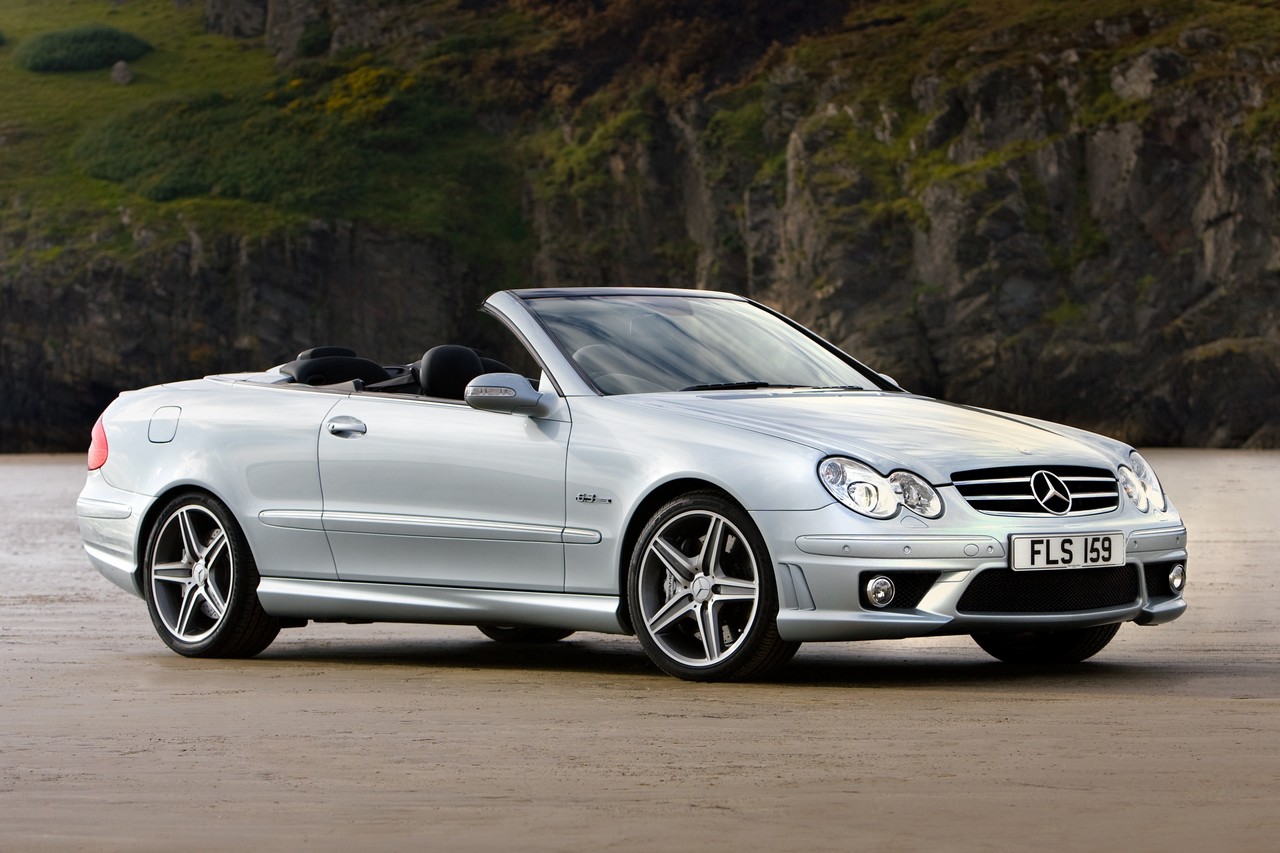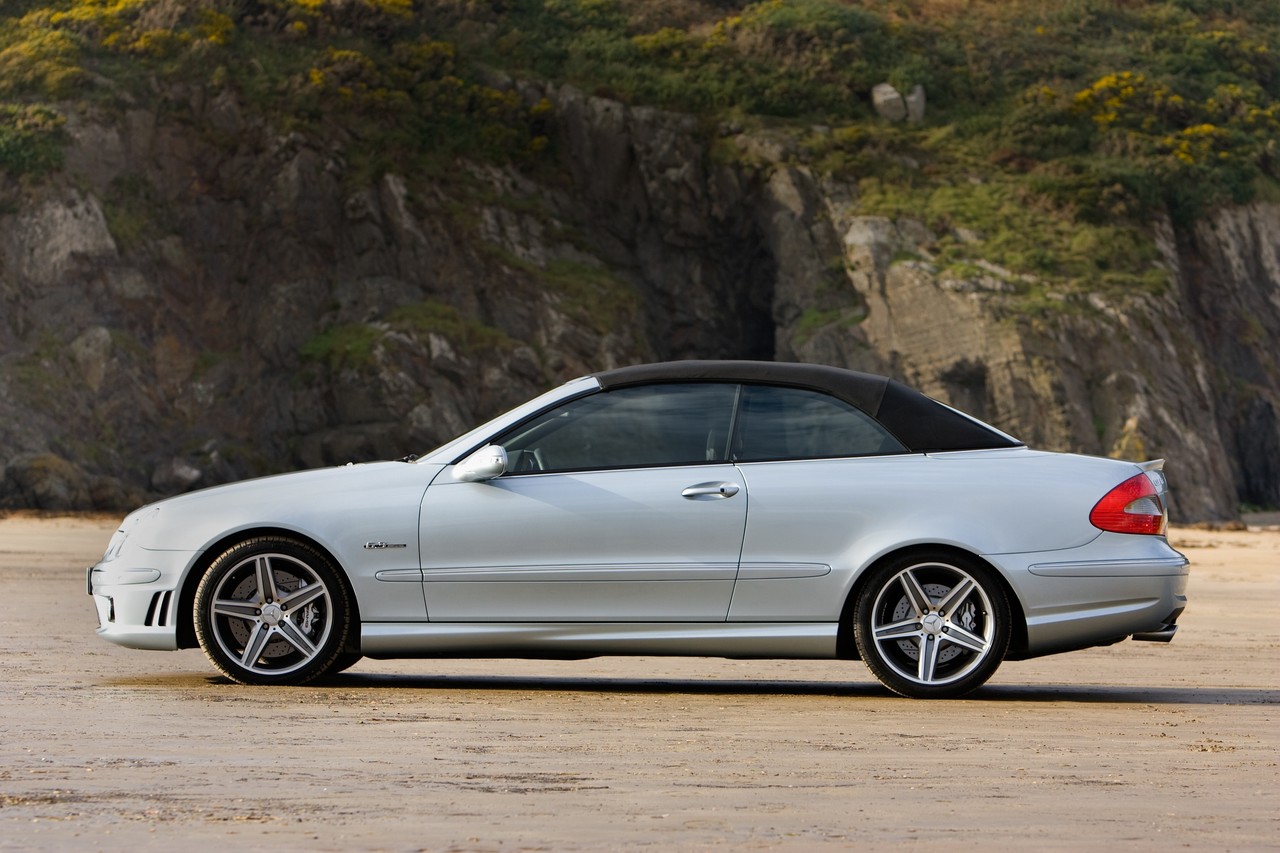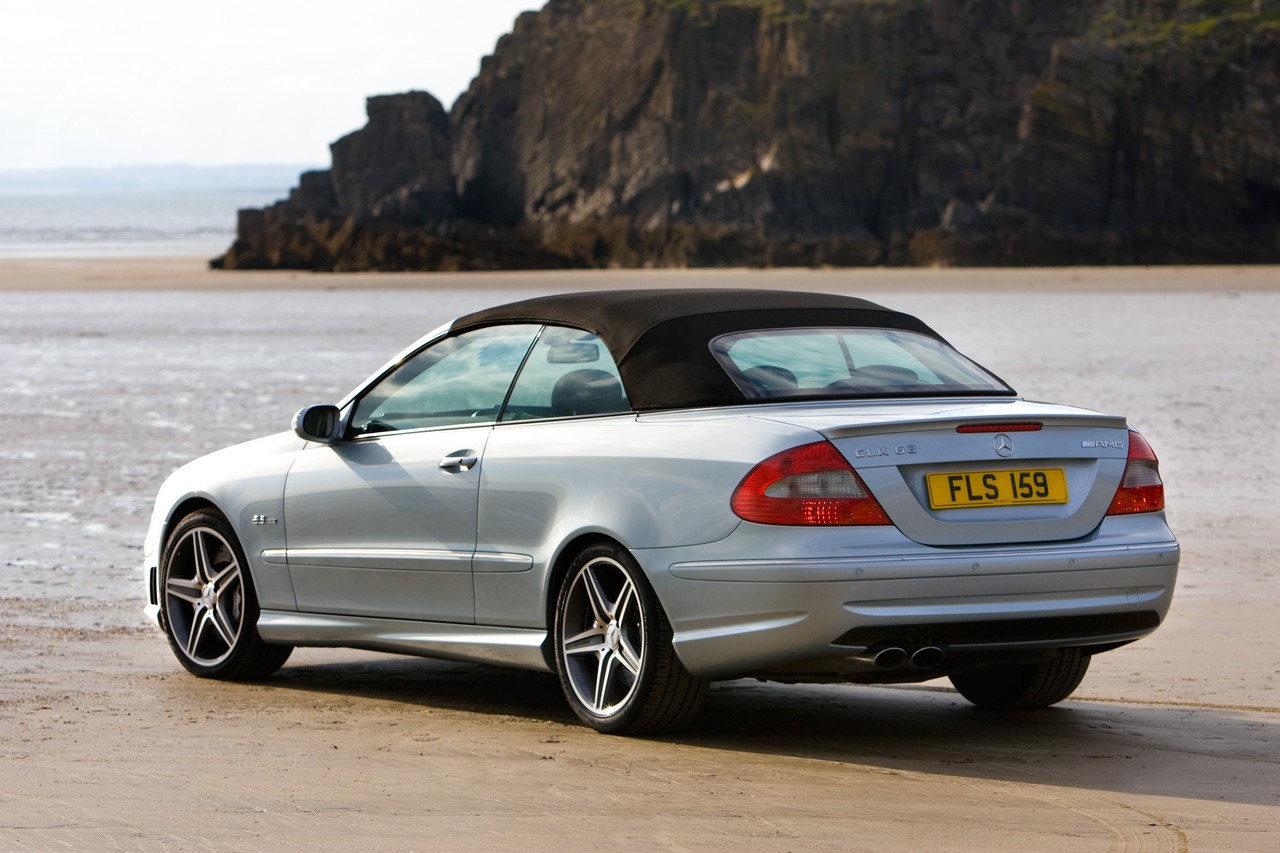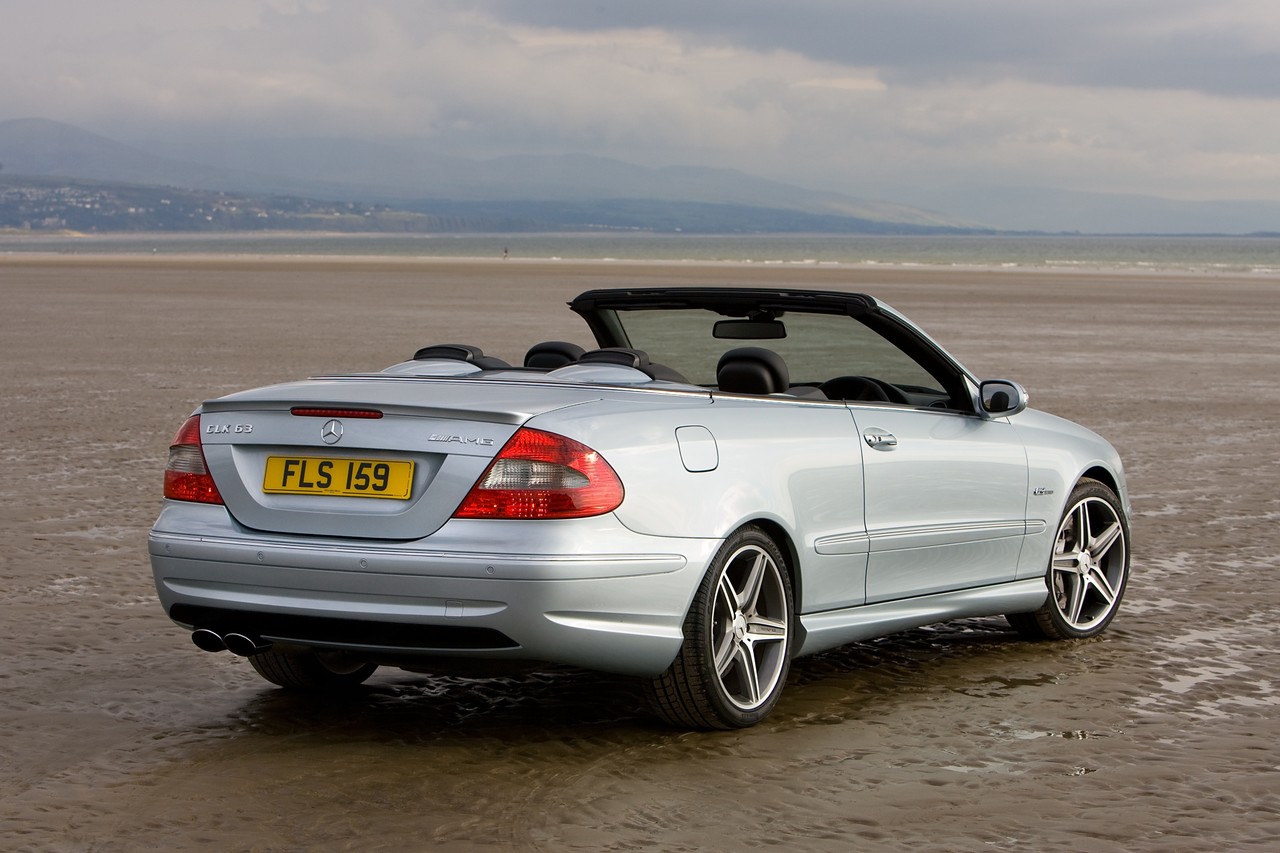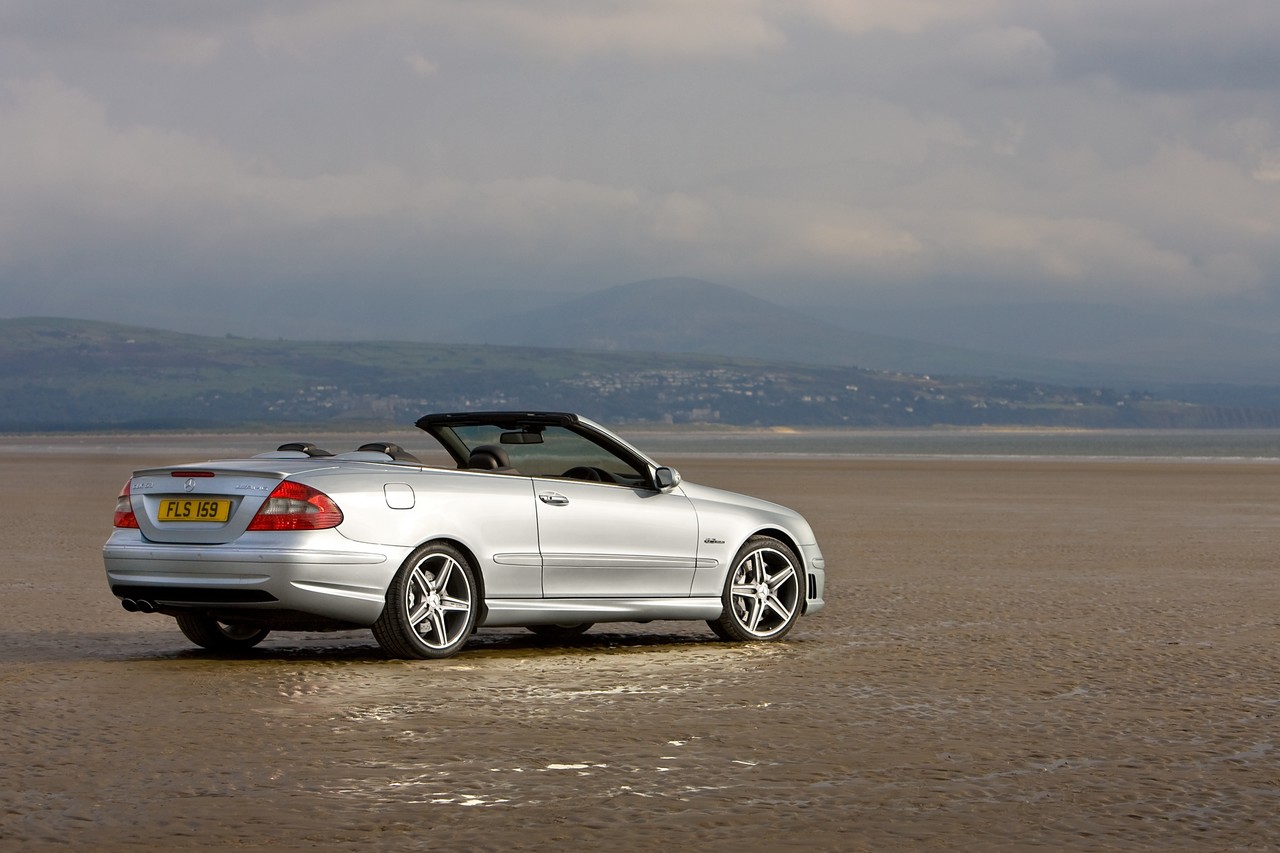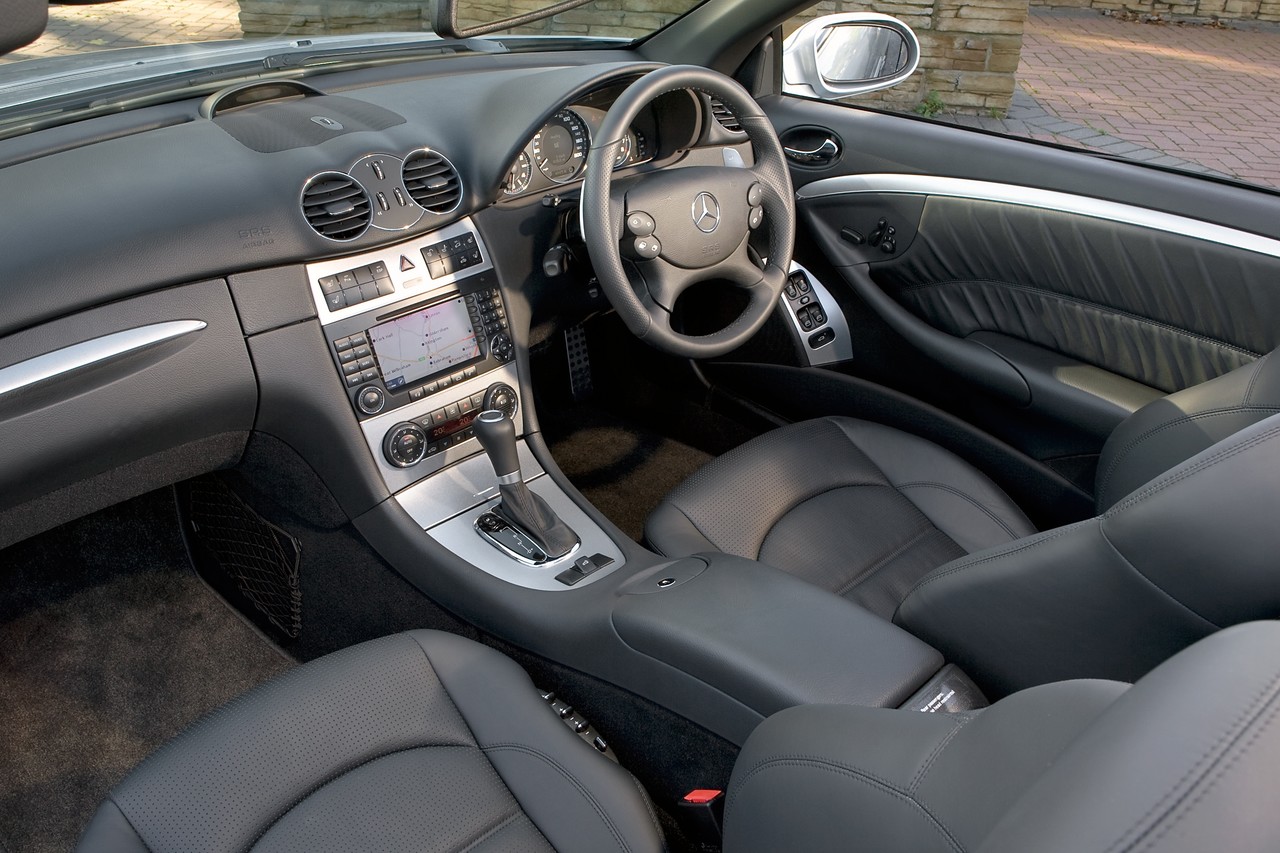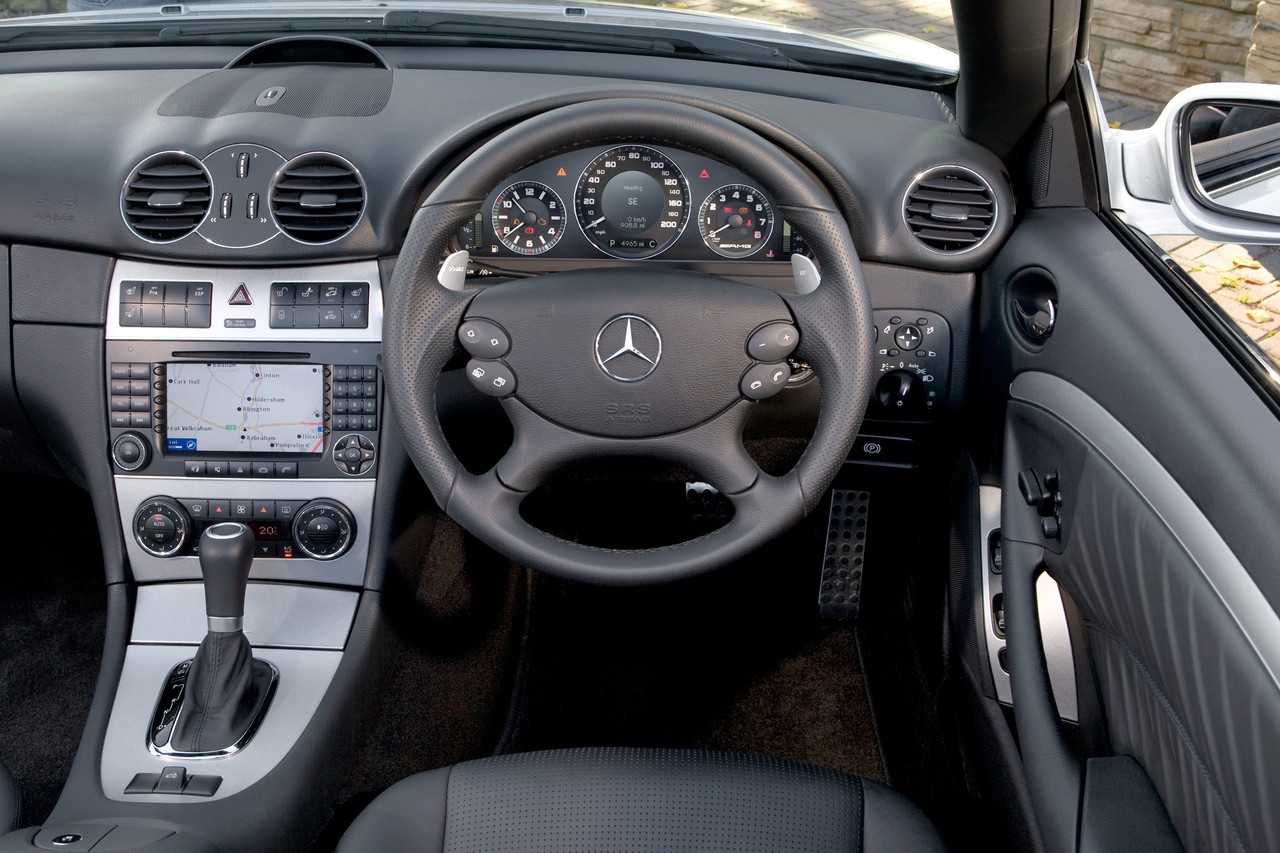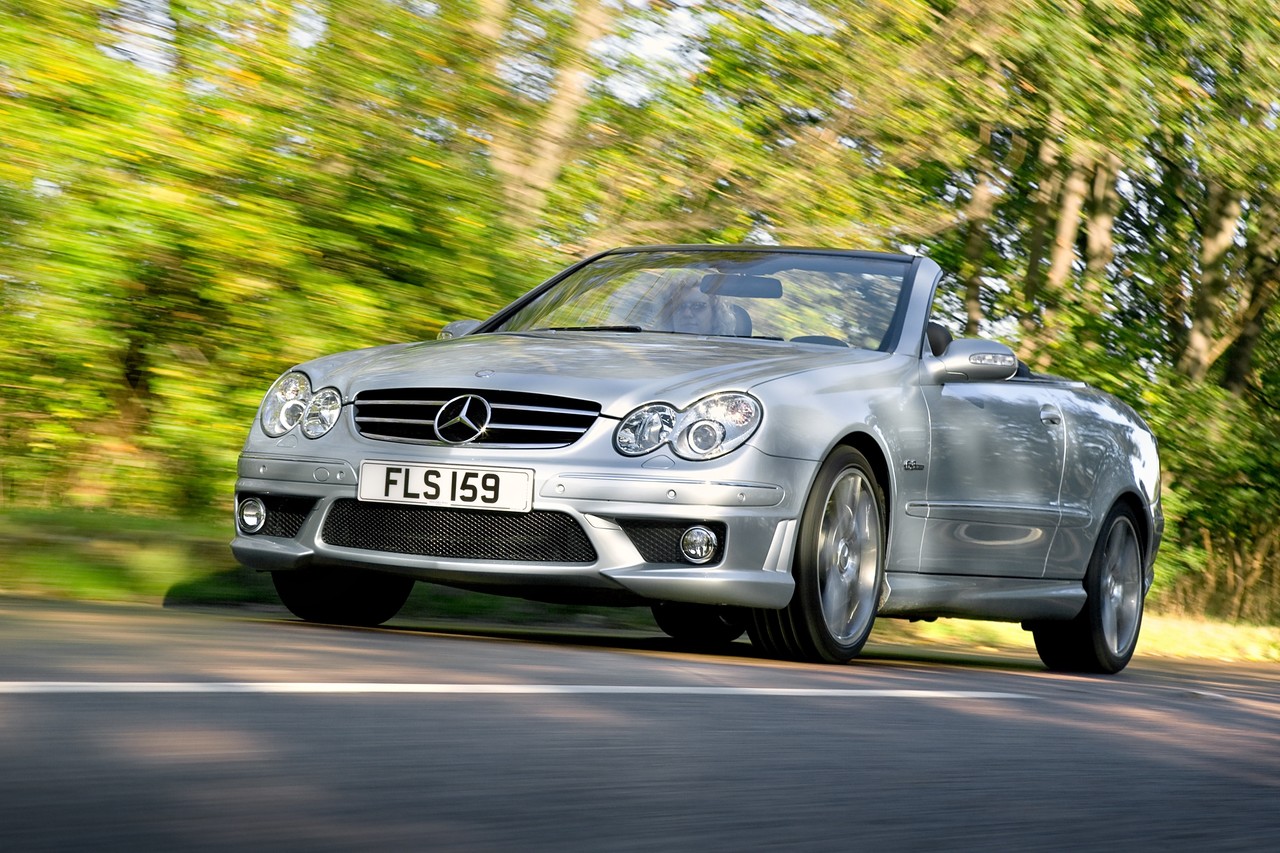
- Chassis overwhelmed by the engines
- M156 V8 engine susceptible to cylinder head bolt failure, camshaft lobe and valve lifter wear
- Brake pedal lacks sensitivity for initial travel
- Lacks dynamic ability, precision and driver engagement of BMW E46 M3 Convertible
Review: Mercedes A209.I CLK 55 AMG Cabriolet (2003-05)
Overview
Released in Australia in August 2003, the Mercedes-Benz A209 CLK 55 AMG was a four-seat cabriolet with a power-operated, soft-top roof. Manufactured in Germany, the rear-wheel drive A209 CLK 55 AMG Cabriolet was powered by a 5.4-litre V8 petrol engine that was mated to a five-speed automatic transmission.
M113.987 V8 engine
Assembled by hand, the 5439 cc M113.987 V8 engine had a die-cast alloy block with 97.0 mm bores and a 92.0 mm stroke, cast-in Silitec cylinder liners, fracture-split forged steel connecting rods, iron-coated aluminium pistons with oil spray cooling, an alloy cylinder head, a single overhead camshaft (SOHC) per cylinder bank driven by a double-roller chain, three valves per cylinder (two intake, one exhaust) actuated by roller rockers, two-spark plugs per cylinder, a dual-length intake manifold and a compression ratio of 11.0:1. Maximum engine speed was 6700 rpm.
The A209 CLK 55 AMG Cabriolet could accelerate from rest to 100 km/h in 5.4 seconds and had an electronically-limited top speed of 250 km/h. Over the combined NEDC test cycle, fuel consumption was 12.3 litres per 100 km.
| Engine | Trans. | Peak power | Peak torque | |
|---|---|---|---|---|
| CLK 55 AMG | 5.4-litre petrol V8 (M113 EVO) | 5sp auto | 270 kW at 5750 rpm | 510 Nm at 4000 rpm |
Transmission
The five-speed automatic transmission had a single-plate dry clutch with the following gear ratios: 3.59 (1st), 2.19 (2nd), 1.41 (3rd), 1.00 (4th) and 0.83 (5th); the final drive ratio was 3.06. The transmission also featured a ‘Speedshift’ manual shift mode that could be activated by pressing the program select button on the automatic selector lever. Then, the right and left switches positioned behind the top two steering wheel spokes could be used for up- and down-shifts, respectively.
Dimensions and body
Compared to the related C209 CLK 55 AMG Coupe , the Mercedes-Benz CLK 55 AMG Cabriolet had the same length (at 4638 mm), width (1740 mm) and wheelbase length (2715 mm), but was 9 mm lower (at 1405 mm) and 105 kg heavier (kerb weight of 1820 kg).
When the soft-top roof was raised, the CLK 55 AMG Cabriolet had a drag coefficient of 0.30 Cd and boot capacity of 390 litres. Furthermore, the spoiler lip on the boot lid reduced lift on the rear axle by over 50 per cent.
Suspension
The Mercedes-Benz A209 CLK 55 AMG Cabriolet had three-link front suspension with MacPherson struts, coil springs, twin-tube gas-pressure shock absorbers and an anti-roll bar. The multi-link rear suspension, however, had coil springs, single-tube gas-pressure shock absorbers and an anti-roll bar.
Steering
The Mercedes-Benz CLK 55 AMG Cabriolet had rack-and-pinion steering with speed-sensitive power assistance (Mercedes-Benz’s ‘parameter steering’). In January 2005, ‘parameter steering’ was replaced by ‘Direct Control’ steering which included modified axle bearings.
Safety equipment
Standard safety equipment for the Mercedes-Benz CLK 55 AMG Cabriolet included dual front airbags (with two-stage deployment), front seat-mounted side airbags with head and thorax protection, rear side airbags, ABS, brake assist, electronic stability control, traction control and seatbelts with pre-tensioners and load limiters for all seats.
Brakes
Like the W203 C 55 AMG , the Mercedes-Benz CLK 55 AMG Cabriolet had 345 mm by 30 mm front brake discs with four-piston callipers and 300 mm by 22 mm rear discs with two-piston rear callipers; both front and rear discs were internally ventilated and perforated.
Features: Mercedes-Benz CLK 55 AMG
Standard features for the Mercedes-Benz CLK 55 AMG Cabriolet included 17-inch AMG alloy wheels (7.5J x 18 front and 8.5J x 18 rear) with 225/45 R17 front and 245/40 R17 rear tyres, a seven speaker sound system with a ten-disc CD changer, Mercedes-Benz’s COMAND APS (Cockpit Management and Data System) with satellite navigation and TV receiver, dual-zone climate control air conditioning (‘Thermotronic’), two-tone nappa and nubuk leather upholstery, front AMG sports seats with power adjustment and heating, cruise control (‘Speedtronic’), bi-xenon headlights, front fog lamps, a rear fog lamp, automatic headlights, rain-sensing wipers, a leather-wrapped AMG steering wheel, split and folding rear seats, remote central locking, power adjustable and heated mirrors with automatic dipping on reverse, power windows, a power adjustable steering column (for height and reach), memory settings (for the front seats and steering wheel), push-button start, illuminated vanity mirrors, tinted windows, aluminium interior trim, a trip computer and immobiliser.
Inside, the CLK 55 AMG Coupe featured nubuk leather for the door panels and perforated seat cushions – available in anthracite, merlot red or dark blue shades – and nappa leather in anthracite for all other leather surfaces.
From January 2005, the CLK 55 AMG Cabriolet was fitted with rear parking sensors.
Related links
Review: Mercedes A209.II CLK 55 & 63 AMG Cabriolet (2005-09)
Overview
Released in August 2005, the Mercedes-Benz A209 Series II (A209.II) CLK 55 AMG introduced updated styling, upgraded electronics and additional features. Visually, the A209.II CLK Cabriolet could be identified by its redesigned ‘wedge shaped’ front bumpers and larger airdam.
Like the A209.II CLK Cabriolet, the A209.II CLK 55 AMG was fitted with a MOST (Media Oriented Serial Transport) media system which included an upgraded DVD-based navigation system; the CAN-bus (controller area network) was also upgraded for greater reliability.
In August 2006, the CLK 63 AMG Cabriolet – powered by the 6.2-litre M156 V8 petrol engine – replaced the CLK 55 AMG. Relative to the CLK 55 AMG, the CLK 63 AMG Cabriolet was 55 kg heavier, with a kerb weight of 1875 kg.
CLK 63 AMG Cabriolet: M156.982 V8 engine
Developed and hand-assembled by Mercedes-AMG in Affalterbach, Germany, the 6208 cc M156.982 V8 petrol engine had an aluminium-silicon alloy (AlSi7) block which had 102.2 mm bores and a 94.6 mm stroke, an aluminium-silicon alloy (AlSi17) cylinder head, a Cromax 42CrMo4V forged steel alloy crankshaft, fracture-split forged connecting rods, cylinder bores with twin-wire-arc-sprayed (TWAS) coating, Bosch 9.7 engine management system, double overhead camshafts per cylinder bank (intake cams driven by a double chain from the crankshaft and small gears on the intake cams drive the exhaust camshafts), continuously variable intake and exhaust camshafts (over a range of 40 degrees via electrohydraulic vane-type adjusters), four valves per cylinder (40 mm intake valves and 34 mm exhaust valves) with bucket tappets, a magnesium variable intake manifold (with two integral throttle flaps) and a compression ratio of 11.3:1. Maximum engine speed for the M156 V8 engine was 7200 rpm.
The CLK 63 AMG Cabriolet could accelerate from rest to 100 km/h in 4.7 seconds; its top speed was electronically limited to 250 km/h. Over the combined EUDC test cycle, fuel consumption was 14.2 litres per 100 km.
| Year | Engine. | Trans. | Peak power | Peak torque | |
|---|---|---|---|---|---|
| CLK 55 AMG | 2006 | 5.4-litre petrol V8 (M113 EVO) | 5sp auto | 270 kW at 5750 rpm | 510 Nm at 4000 rpm |
| CLK 63 AMG | 2006-09 | 6.2-litre petrol V8 (M156) | 7sp auto | 354 kW at 6800 rpm | 630 Nm at 5000 rpm |
CLK 63 AMG Cabriolet: AMG Speedshift 7G-Tronic transmission
For the seven-speed ‘AMG Speedshift Plus 7G-Tronic’ automatic transmission, the gear ratios were 4.38 (1st), 2.86 (2nd), 1.92 (3rd), 1.37 (4th), 1.00 (5th), 0.82 (6th) and 0.73 (7th), while the final drive ratio was 2.65. Furthermore, the driver could perform gearshifts using the steering wheel paddles and select from three drive programs:
- Comfort, ‘C’, for softer throttle response, smooth gearshifts and early upshifts to minimise fuel consumption;
- Sport, ‘S’, for greater throttle response, higher engine speeds before upshifting and gearshifts that were around 30 per cent faster than in Comfort; and,
- Manual, ‘M’, for gearshifts via the paddles, maximum throttle response and gearshifts that were around 20 per cent faster than in Sport.
The transmission also featured an automatic throttle-blipping function during downshifts for almost jolt-free gearshifts and to reduce load-change responses.
Safety equipment
Compared to its A209.I predecessor, safety equipment for the A209.II CLK 55 AMG Cabriolet was improved with the introduction of active front seat head restraints (Mercedes-Benz’s ‘Neck-Pro’).
Brakes: CLK 55 AMG and CLK 63 AMG Cabriolets
For the A209.II CLK 55 AMG, the braking package was upgraded with six-piston front callipers and four-piston rear callipers; dimensions continued to be 345 mm by 30 mm for the front discs and 300 mm by 22 mm for the rear.
Upon its release in 2006, the CLK 63 AMG had the same braking package as the A209.II CLK 55 AMG.
Features: CLK 55 AMG and CLK 63 AMG Cabriolets
Compared to its A209.I predecessor, standard features for the CLK 55 AMG Cabriolet were extended to include a Harman Kardon Logic7 surround sound system, tyre pressure monitoring and anti-theft alarm system.
Upon its introduction, the CLK 63 AMG had similar features to the CLK 55 AMG, though changes included new AMG sports seats, Nappa leather upholstery (in black, basalt grey or sand), new contoured steering wheel with perforated leather sections, aluminium gearshift paddles and polished stainless steel sports pedals.
Related links
